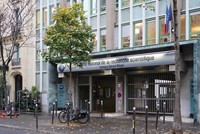Advertisement
Grab your lab coat. Let's get started
Welcome!
Welcome!
Create an account below to get 6 C&EN articles per month, receive newsletters and more - all free.
It seems this is your first time logging in online. Please enter the following information to continue.
As an ACS member you automatically get access to this site. All we need is few more details to create your reading experience.
Not you? Sign in with a different account.
Not you? Sign in with a different account.
ERROR 1
ERROR 1
ERROR 2
ERROR 2
ERROR 2
ERROR 2
ERROR 2
Password and Confirm password must match.
If you have an ACS member number, please enter it here so we can link this account to your membership. (optional)
ERROR 2
ACS values your privacy. By submitting your information, you are gaining access to C&EN and subscribing to our weekly newsletter. We use the information you provide to make your reading experience better, and we will never sell your data to third party members.
Publishing
Small gap found in error reporting at JACS
Most but not all retracted or corrected studies in journal are appropriately labeled
by Dalmeet Singh Chawla, special to C&EN
July 18, 2023
More than 97% of the studies that have been retracted or corrected by the Journal of the American Chemical Society (JACS) in the last 2 decades are appropriately labeled, a new study finds. Still, almost 20 retracted papers were mislabeled as corrections, the analysis reveals.
18
Number of retracted papers in the Journal of the American Chemical Society that were mislabeled as corrections.
The study is due to be presented in September at the 27th International Conference on Science, Technology and Innovation Indicators in Leiden, the Netherlands. The analysis is part of the European Commission’s Nano bubbles project, which aims to explore how, when, and why science fails to correct itself. JACS is published by the American Chemical Society, which also publishes C&EN.
Study author Frédérique Bordignon, who studies research integrity and scientometrics at École des Ponts ParisTech in France, examined 1,083 editorial notices issued by JACS between 2000 and 2023.
According to a 2010 study, JACS had to correct 1.4% of the more than 17,000 papers it published between 2000 and 2005. The new study found that 97.4% of the papers associated with a retraction or correction are correctly displayed on the JACS website.
“I don’t think we can be happy with these numbers,” Bordignon tells C&EN. “We need 100% because we need to be 100% sure of the papers, the content, the data, the images we are using for further research.”
In her research, Bordignon found 18 corrections that should in fact have been labeled as retractions on the JACS website. What’s more, out of these 18, 17 are labeled correctly as retractions on PubMed and 10 on Web of Science. That suggests a lack of consistency across different databases and repositories.
“It’s a mystery to me,” Bordignon says. “I was expecting the publisher’s source to be the best one so that we can rely on and be sure that all the other sources need to refer to that one source to be accurate, but that is not the case. For instance, PubMed is sometimes more accurate than the publisher itself.” Erick Carreira, the editor-in-chief of JACS, didn’t respond to requests for comment.
Bordignon says the inconsistency is a problem because researchers may come across the same paper from different sources and not be clear on whether it’s retracted or not. She attributes the inconsistencies between publisher sites and indexing repositories to a lack of time, effort, and resources being dedicated to make sure the correct information is displayed on all sources.
Todd Carpenter, executive director of the Maryland-based National Information Standards Organization, agrees that editorial notices need to be communicated consistently across different publishers. Carpenter’s organization is working on recommendations about how to communicate retractions, corrigenda, errata, withdrawals, expressions of concern, and other types of notices.





Join the conversation
Contact the reporter
Submit a Letter to the Editor for publication
Engage with us on Twitter